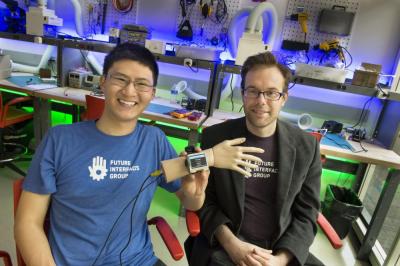HCII Researchers Develop New Approaches to Smartwatches

Carnegie Mellon University's Future Interfaces Group is exploring wearable technologies to make information and communication even more accessible. One of those is a smart watch that allows users to access the information they need through an interface that isn’t as cumbersome as some wearable technologies currently available.
"For highly glance-able information such as notifications, directions, an upcoming meeting or your calendar, our smartwatch is much less distracting, and it's much less socially intrusive," said HCII Assistant Professor Chris Harrison, who directs the Future Interfaces Group.
One of the biggest challenges in academia is getting innovative ideas out of the lab and into the public eye, so Harrison and doctoral student Robert Xiao recently demonstrated the technology for international journalists at a conference in Pittsburgh.
"The press is really the avenue to get ideas into the public. What people want, industry follows. Our job is to get the interesting — and sometimes crazy — ideas out there, to get people excited," Harrison said.
Xiao and Harrison, whose team also includes doctoral student Gierad Laput, showed the audience how a user could check time and calendar meetings, find directions and even play video games on the device.
"To illustrate the potential of our approach, we developed a series of example applications, many of which are cumbersome — or even impossible — on today's smartwatch devices," Xiao said.
Wearable technology is a multibillion industry still in its infancy. Rumors of Microsoft and Apple smartwatches have been circulating for about a year.
"The era of worn computers is imminent — starting with technologies like smartwatches and Google Glass — but no company has quite cracked the nut yet. ... The interface continues to be a stubborn problem," Harrison said. "Worn interfaces must be small to be unobtrusive, but our fingers are relatively large. This means we have to think beyond touch interaction to use these devices effectively."
By using the watch face as a multi-degree-of-freedom mechanical interface, their approach enables rich interaction without obstructing the screen with fingers. The prototype supports continuous 2D panning and twisting as well as binary tilt and click. (Watch the video demonstration.)
"Through Chris's tutelage, and just hacking on things, I'm developing the technical skills necessary to tackle and implement cutting-edge ideas — to take formless ideas and turn them into physical manifestations and actually test them and show them in the real world,” Xiao said.
Xiao admits that working on human-computer interaction at small scales is difficult, and said that he feels fortunate to conduct his research in what he calls the best human-computer interaction program in the world.
"This is an awesome, awesome place to work. There are lots of cool ideas, lots of cool people, lots of really neat technologies we get to play with," he said. "This is definitely the place to go if you want to do some serious forward-thinking in your research."
Harrison pointed out that CMU has the first degree-granting HCI program in the world.
"In most places there may be only one lab or a single professor who does HCI. CMU made a big bet 20 years ago, and this was before anyone was really thinking about it," he said.
Harrison said research is not just about publishing papers.
"Getting people excited about technology — getting people to go into technology careers, take technology classes, get people into research — all generates economic activity," Harrison said. "It has all of these incredible ripple effects."
Harrison and Xiao are exploring other ways to improve multi-touch devices beyond the smartwatch. They are co-founders of Qeexo, a startup company that develops "rich-touch" interactive technologies spun off from CMU in 2013. The company, with a business office in San Jose, Calif., and a research and development office in Pittsburgh, announced $2.3 million in Series A funding at the end of May.

